Where to from Here? Women Remain Absent from Senior Academic Positions at Aotearoa New Zealand’s Universities
Abstract
1. Introduction
2. Materials and Methods
2.1. Data Acquisition
2.2. Data Analysis
2.2.1. Progress Towards Gender Parity
2.2.2. Do Gender Differences in the Age Distribution of Academic Staff Explain Why There Are Few Women at Senior Levels?
2.2.3. Do Women Advance at the Same Rate as Men?
3. Results
3.1. Women’s Participation in the Aotearoa New Zealand Academy
3.1.2. Part-Time vs. Full-Time Staff
3.1.3. When Would We Predict Parity in Employment?
3.2. Women’s Career Progression
3.2.1. Are Men and Women Equally Represented at All Levels of Academic Staff within NZ Universities?
3.2.2. Do Women Advance at the Same Rate as Men?
4. Discussion
Author Contributions
Funding
Acknowledgments
Conflicts of Interest
Appendix A
- A female dummy interacted with academic level;
- A dummy for 2016, when data definitions changed, interacted with level; and
- Fixed effects for level.
- The model makes two simplifying assumptions. Firstly, we assumed that the rate of promotion does not vary within gender at each level. Secondly, we did not explicitly model being promoted out of a level, although this is allowed for.
Appendix B
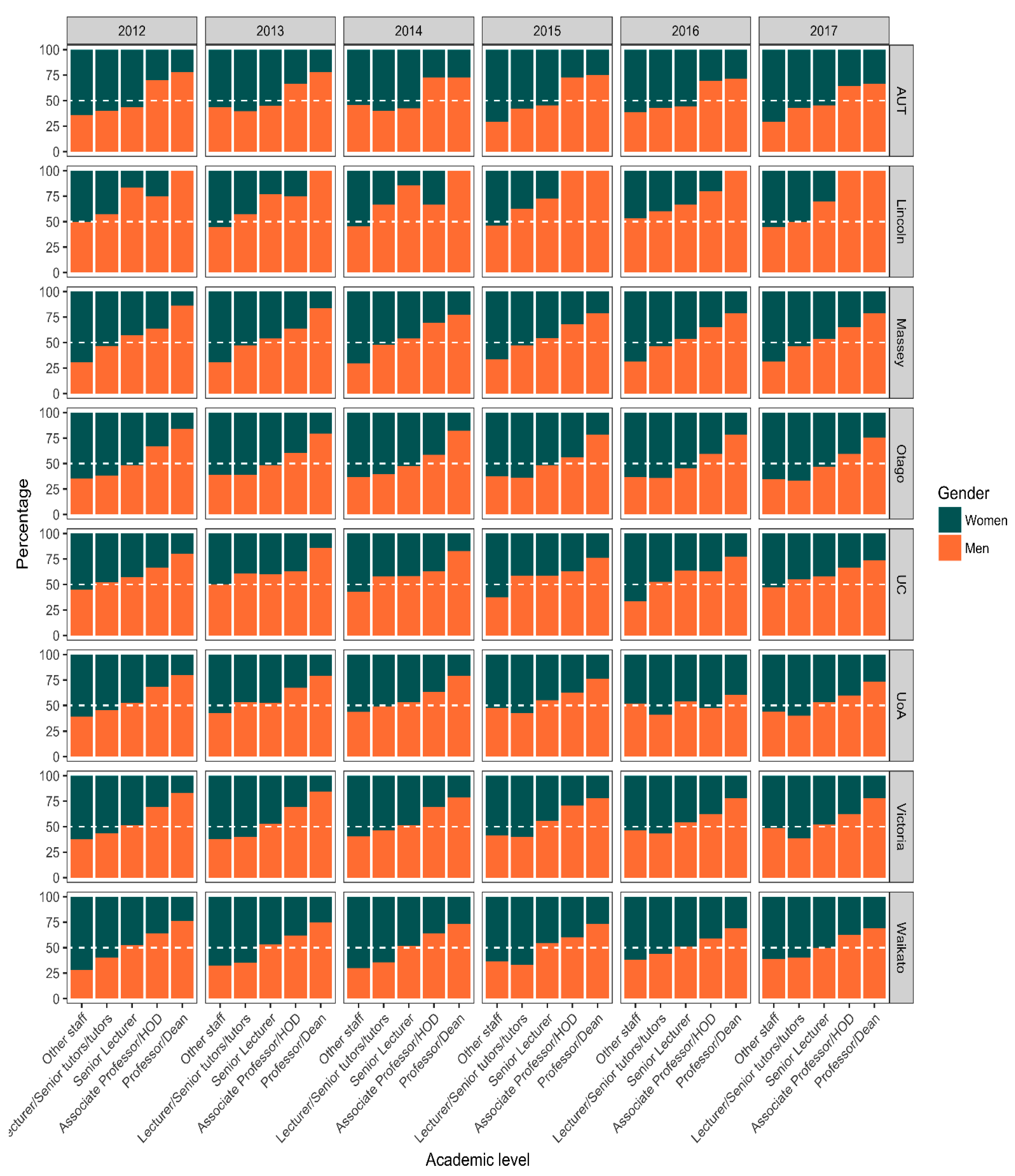
Appendix C
Do Gender Differences in the Age Distribution of Academic Staff Explain Why There Are Few Women at Senior Levels?
| 2012 | |||
|---|---|---|---|
| Academic Level | Actual % of Men | Actual % of Women | Counterfactual % of Women |
| Professors/Deans | 19.0% | 5.3% | 16.8% |
| Assoc. Professors/Heads of Department | 15.3% | 8.1% | 14.7% |
| Senior Lecturers/Principal Lecturers | 32.4% | 32.2% | 32.9% |
| Lecturers/Senior tutors/Tutors | 13.8% | 18.5% | 14.8% |
| Other academic staff/Tutorial assistants | 19.5% | 35.8% | 20.8% |
| 2017 | |||
|---|---|---|---|
| Academic Level | Actual % of Men | Actual % of Women | Counterfactual % of Women |
| Professors/Deans | 19.0% | 5.3% | 16.8% |
| Assoc. Professors/Heads of Department | 15.3% | 8.1% | 14.7% |
| Senior Lecturers/Principal Lecturers | 32.4% | 32.2% | 32.9% |
| Lecturers/Senior tutors/Tutors | 13.8% | 18.5% | 14.8% |
| Other academic staff/Tutorial assistants | 19.5% | 35.8% | 20.8% |
References and Note
- Bridgman, T. Assassins in Academia? New Zealand Academics as “Critic and Conscience of Society” N. Z. Sociol. 2007, 22, 126–144. [Google Scholar]
- Education Act 1989 (New Zealand) 162 4(a)(v)
- Sugimoto, C.R. Global gender disparities in science. Nature 2013, 504, 211–213. [Google Scholar]
- Xu, Y.J. Gender Disparity in STEM Disciplines: A Study of Faculty Attrition and Turnover Intentions. Res. High. Educ. 2008, 49, 607–624. [Google Scholar] [CrossRef]
- Umbach, P.D. Gender equity in the academic labor market: An analysis of academic disciplines. Res. High. Educ. 2006, 48, 169–192. [Google Scholar] [CrossRef]
- Naepi, S. Why isn’t my professor Pasifika? A snapshot of the academic workforce in New Zealand universities. MAI J. N. Z. J. Indig. Scholarsh. 2019, 8, 219–234. [Google Scholar]
- McAllister, T.; Kidman, J.; Rowley, O.; Theodore, R. Why isn’t my professor Māori? A snapshot of the academic workforce in New Zealand universities. MAI J. N. Z. J. Indig. Scholarsh. 2019, 8, 236–249. [Google Scholar]
- Carr, P.L.; Raj, A.; Kaplan, S.E.; Terrin, N.; Breeze, J.L.; Freund, K.M. Gender Differences in Academic Medicine: Retention, Rank, and Leadership Comparisons From the National Faculty Survey. Acad. Med. 2018, 93, 1694–1699. [Google Scholar] [CrossRef]
- Ceci, S.J.; Ginther, D.K.; Kahn, S.; Williams, W.M. Women in Academic Science: A Changing Landscape. Psychol. Sci. Public Interest 2014, 15, 75–141. [Google Scholar] [CrossRef]
- Ginther, D.K.; Kahn, S. Women in Economics: Moving Up or Falling Off the Academic Career Ladder? J. Econ. Perspect. 2004, 18, 193–214. [Google Scholar] [CrossRef]
- Hill, B.; Secker, J.; Davidson, F. Achievement relative to opportunity: Career hijacks in the academy. Adv. Gend. Res. 2014, 19, 85–107. [Google Scholar]
- Association of Pacific Rim Universities. ‘2019 APRU Gender Gap Report’. University of Sydney. 2019. Available online: https://apru.org/wp-content/uploads/2019/07/2019-APRU-Gender-Gap-Report.pdf (accessed on 15 August 2019).
- Benschop, Y.; Brouns, M. Crumbling Ivory Towers: Academic Organizing and its Gender Effects. Gend. Work Organ. 2003, 10, 194–212. [Google Scholar] [CrossRef]
- Dwyer, K.M.; Clark, C.J.; MacDonald, K.; Paraskeva, M.A.; Rogers, N.; Ryan, J.; Webster, A.C.; Wong, G. Gender Equity in Transplantation: A Report from the Women in Transplantation Workshop of The Transplantation Society of Australia and New Zealand. Transplantation 2017, 101, 2266–2270. [Google Scholar] [CrossRef] [PubMed]
- Brower, A.; James, A. Research performance and age explain less than half of the gender pay gap in New Zealand universities. PLoS ONE 2020, 15, e0226392. [Google Scholar] [CrossRef] [PubMed]
- Amery, F.; Bates, S.; Jenkins, L.; Savigny, H. Metaphors on Women in Academia: A Review of the Literature, 2004–2013. In Advances in Gender Research; Demos, V., Texler Segal, M., Eds.; Emerald Group Publishing Limited: Bingley, UK, 2015; Volume 20, pp. 245–267. ISBN 978-1-78560-079-1. [Google Scholar]
- Bismark, M.; Morris, J.; Thomas, L.; Loh, E.; Phelps, G.; Dickinson, H. Reasons and remedies for under-representation of women in medical leadership roles: A qualitative study from Australia. BMJ Open 2015, 5, e009384. [Google Scholar] [CrossRef]
- Nonnemaker, L. Women Physicians in Academic Medicine—New Insights from Cohort Studies. N. Engl. J. Med. 2000, 342, 399–405. [Google Scholar] [CrossRef] [PubMed]
- Gumpertz, M.; Durodoye, R.; Griffith, E.; Wilson, A. Retention and promotion of women and underrepresented minority faculty in science and engineering at four large land grant institutions. PLoS ONE 2017, 12, e0187285. [Google Scholar] [CrossRef]
- Sege, R.; Nykiel-Bub, L.; Selk, S. Sex Differences in Institutional Support for Junior Biomedical Researchers. JAMA 2015, 314, 1175. [Google Scholar] [CrossRef]
- Lundberg, S.; Stearns, J. Women in Economics: Stalled Progress. J. Econ. Perspect. 2019, 33, 3–22. [Google Scholar] [CrossRef]
- Mairesse, J.; Pezzoni, M. Does gender affect scientific productivity? A critical review of the empirical evidence and a panel data econometric analysis for French physicists. Rev. Econ. 2015, 66, 65–113. [Google Scholar]
- Ferriman, K.; Lubinski, D.; Benbow, C.P. Work preferences, life values, and personal views of top math/science graduate students and the profoundly gifted: Developmental changes and gender differences during emerging adulthood and parenthood. J. Pers. Soc. Psychol. 2009, 97, 517–532. [Google Scholar] [CrossRef]
- Sieverding, M.; Eib, C.; Neubauer, A.B.; Stahl, T. Can lifestyle preferences help explain the persistent gender gap in academia? The “mothers work less” hypothesis supported for German but not for U.S. early career researchers. PLoS ONE 2018, 13, e0202728. [Google Scholar] [CrossRef] [PubMed]
- Adamo, S.A. Attrition of Women in the Biological Sciences: Workload, Motherhood, and Other Explanations Revisited. BioScience 2013, 63, 43–48. [Google Scholar]
- Wolfinger, N.H.; Mason, M.A.; Goulden, M. Problems in the Pipeline: Gender, Marriage, and Fertility in the Ivory Tower. J. High. Educ. 2008, 79, 388–405. [Google Scholar] [CrossRef]
- Knights, D.; Richards, W. Sex Discrimination in UK Academia. Gend. Work Organ. 2003, 10, 213–238. [Google Scholar] [CrossRef]
- Sardelis, S.; Drew, J.A. Not “Pulling up the Ladder”: Women Who Organize Conference Symposia Provide Greater Opportunities for Women to Speak at Conservation Conferences. PLoS ONE 2016, 11, e0160015. [Google Scholar] [CrossRef]
- Buckley, H.L.; Sciligo, A.R.; Adair, K.L.; Case, B.S.; Monks, J.M. Is there gender bias in reviewer selection and publication success rates for the. N. Z. J. Ecol. 2014, 38, 5. [Google Scholar]
- Jimenez, M.F.; Laverty, T.M.; Bombaci, S.P.; Wilkins, K.; Bennett, D.E.; Pejchar, L. Underrepresented faculty play a disproportionate role in advancing diversity and inclusion. Nat. Ecol. Evol. 2019, 3, 1030–1033. [Google Scholar] [CrossRef]
- Ehrenberg, R.G.; Jakubson, G.H.; Martin, M.L.; Main, J.B.; Eisenberg, T. Diversifying the faculty across gender lines: Do trustees and administrators matter? Econ. Educ. Rev. 2012, 31, 9–18. [Google Scholar] [CrossRef]
- Williams, W.M.; Mahajan, A.; Thoemmes, F.; Barnett, S.M.; Vermeylen, F.; Cash, B.M.; Ceci, S.J. Does Gender of Administrator Matter? National Study Explores U.S. University Administrators’ Attitudes About Retaining Women Professors in STEM. Front. Psychol. 2017, 8, 700. [Google Scholar] [CrossRef]
- Lipton, B. Measures of success: Cruel optimism and the paradox of academic women’s participation in Australian higher education. High. Educ. Res. Dev. 2017, 36, 486–497. [Google Scholar] [CrossRef]
- Gibney, E. UK gender-equality scheme spreads across the world. Nat. News 2017, 549, 143. [Google Scholar] [CrossRef] [PubMed]
- Winchester, H.P.M.; Browning, L. Gender equality in academia: A critical reflection. J. High. Educ. Policy Manag. 2015, 37, 269–281. [Google Scholar] [CrossRef]
- Universities New Zealand. New Zealand Universities Women in Leadership Programme (NZUWiL). Available online: https://www.universitiesnz.ac.nz/about-universities-new-zealand/expert-and-working-groups/new-zealand-universities-women-leadership (accessed on 13 May 2019).
- Ministry of Education. A History and Overview of the PBRF; Ministry of Education: Wellington, New Zealand, 2012.
- Cockburn, R.; Atkinson, L. Summary Interim Report; New Zealand Women in Leadership Programme; Lumin: Wellington, New Zealand, 2010. [Google Scholar]
- Harris, C.A.; Leberman, S.I. Leadership Development for Women in New Zealand Universities: Learning From the New Zealand Women in Leadership Program. Adv. Dev. Hum. Resour. 2012, 14, 28–44. [Google Scholar] [CrossRef]
- Hurst, J.; Leberman, S. New Zealand women in leadership: Opportunities and challenges. In Women and Leadership around the World; Madsen, S.R., Ngunjiri, F.W., Longman, K.A., Cherrey, C., Eds.; Information Age Publishing, Inc.: Charlotte, CA, USA, 2015; pp. 207–226. [Google Scholar]
- Buckles, K. Fixing the Leaky Pipeline: Strategies for Making Economics Work for Women at Every Stage. J. Econ. Perspect. 2019, 33, 43–60. [Google Scholar] [CrossRef]
- Rosser, S.V.; Barnard, S.; Carnes, M.; Munir, F. Athena SWAN and ADVANCE: Effectiveness and lessons learned. Lancet 2019, 393, 604–608. [Google Scholar] [CrossRef]
- Human Rights Commission. New Zealand Census of Women’s Participation 2012; Human Rights Commission: Auckland, New Zealand, 2012; ISBN 978-0-478-35637-3.
- Equal Opportunities Office. Equal Opportunities Office Statistics and Activities Report 2007; The University of Auckland: Auckland, New Zealand, 2007.
- Naepi, S.; McAllister, T.G.; Thomsen, P.; Leenen-Young, M.; Walker, L.A.; McAllister, A.L.; Theodore, R.; Kidman, J.; Suaaliia, T. The Pakaru ‘Pipeline’: Māori and Pasifika Pathways within the Academy. Nzaroe 2020, 24, 142. [Google Scholar] [CrossRef]
- Roa, T.; Beggs, J.R.; Williams, J.; Moller, H. New Zealand’s Performance Based Research Funding (PBRF) model undermines Maori research. J. R. Soc. N. Z. 2009, 39, 233–238. [Google Scholar] [CrossRef][Green Version]
- Jones, D. Possibilities of Transformation: Discourses of Difference in Organisational Communication. Ph.D. Thesis, University of Waikato, Hamilton, New Zealand, 1998. [Google Scholar]
- The University of Auckland Key Statistics. Available online: https://www.auckland.ac.nz/en/about-us/about-the-university/our-ranking-and-reputation/key-statistics.html (accessed on 9 March 2020).
- Auckland University of Technology Annual Report 2018. Available online: https://www.aut.ac.nz/__data/assets/pdf_file/0006/264624/Annual-Report-2018-AUT.pdf (accessed on 9 March 2020).
- The University of Waikato Annual Report 2017. Available online: https://www.waikato.ac.nz/annualreport/2017/University-of-Waikato-Annual-Report-2017.pdf (accessed on 9 March 2020).
- Massey University Annual Report 2017. Available online: https://www.massey.ac.nz/massey/fms/About%20Massey/University-Management/documents/annual-report/massey-university-annual-report-2017.pdf?ED32BC3335191A5A35230F1A1D93401B (accessed on 1 June 2020).
- Wellington Victoria University of Wellington Annual Report 2018. Available online: https://www.victoria.ac.nz/__data/assets/pdf_file/0005/1739678/2018-annual-report.pdf (accessed on 9 March 2020).
- Canterbury University 2018 at a Glance. Available online: https://www.canterbury.ac.nz/media/documents/annual-reports/2-Annual-Report-2018-At-A-Glance.pdf (accessed on 9 March 2020).
- Lincoln University. Lincoln University Annual Report 2018; Lincoln University: Christchurch, New Zealand, 2018. [Google Scholar]
- University of Otago Annual Report. Available online: https://www.otago.ac.nz/about/official-documents/otago710847.pdf (accessed on 9 March 2020).
- Stringer, R.; Smith, D.; Spronken-Smith, R.; Wilson, C. New Zealand Sociology—“My entire career has been fixed term”: Gender and precarious academic employment at a New Zealand university (Humanities & Social Sciences Collection)—Informit. N. Z. Sociol. 2018, 33, 169. [Google Scholar]
- Ministry of Education. Tertiary Education Strategy 2014–2019; Ministry of Education: Wellington, New Zealand; Ministry of Business, Innovation and Employment: Wellington, New Zealand, 2014; ISBN 978-0-478-42255-9.
- Ministry of Education Counts. Available online: https://www.educationcounts.govt.nz/home (accessed on 9 March 2020).
- Education Services Workforce Questionnaires. Available online: http://services.education.govt.nz/steo/staffing-return-and-rs20/workforce-questionnaires/ (accessed on 9 March 2020).
- Mazerolle, M.J. AICcmodavg: Model Selection and Multimodel Inference Based on (Q)AIC(c), R Package Version 2.2-2; 2019. Available online: https://cran.r-project.org/package=AICcmodavg (accessed on 1 June 2020).
- History of the University of Auckland. Available online: https://www.calendar.auckland.ac.nz/en/info/history.html (accessed on 21 April 2020).
- Statistical Consulting Centre. University of Auckland Equity Profile 2014; Equity Office—Te Ara Tautika: Auckland, New Zealand, 2014. [Google Scholar]
- Baker, M. Career confidence and gendered expectations of academic promotion. J. Sociol. 2010. [Google Scholar] [CrossRef]
- Roberts, C. Advancing Women Leaders in Academe: Creating a Culture of Inclusion. Handb. Res. Adm. PolicyLeadersh. High. Educ. 2017, 256–273. [Google Scholar] [CrossRef]
- Alex, J.; Rose, C.; Plank Michael, J. Gender and societies: A grassroots approach to women in science. R. Soc. Open Sci. 2019, 6, 190633. [Google Scholar] [CrossRef]
- Schroen, A.T.; Brownstein, M.R.; Sheldon, G.F. Women in Academic General Surgery. Acad. Med. 2004, 79, 310–318. [Google Scholar] [CrossRef] [PubMed]
- Misra, J.; Smith-Doerr, L.; Dasgupta, N.; Weaver, G.; Normanly, J. Collaboration and Gender Equity among Academic Scientists. Soc. Sci. Basel 2017, 6, 25. [Google Scholar] [CrossRef]
- Xie, Y.; Shauman, K.A. Women in Science: Career Processes and Outcomes; Harvard Univ. Press: Cambridge, MA, USA, 2009; ISBN 978-0-674-01034-5. [Google Scholar]
- Bailey, J.; Troup, C.; Strachan, G. Part-time work and advancement: A study of female professional staff in Australian universities. J. High. Educ. Policy Manag. 2017, 39, 282–295. [Google Scholar] [CrossRef]
- Mason, M.A.; Wolfinger, N.H.; Goulden, M. Introduction. In Do Babies Matter? Gender and Family in the Ivory Tower; Rutgers University Press: New Brunswick, NJ, USA, 2013; pp. 1–7. ISBN 978-0-8135-6081-6. [Google Scholar]
- Roberts, P. The Future of the University: Reflections from New Zealand. Int. Rev. Educ. 1999, 45, 65–86. [Google Scholar] [CrossRef]
- Nicholls, L. Where Have All the Postdocs Gone? The Blockage in Our Science “Talent Pipe”. Available online: https://www.noted.co.nz/currently/currently-science/where-have-all-the-postdocs-gone-the-blockage-in-our-science-talent-pipe (accessed on 9 September 2019).
- Diezmann, C.; Grieshaber, S. Critical Events and Academic Women’s Career Profiles. In Women Professors: Who Makes It and How? Diezmann, C., Grieshaber, S., Eds.; Springer: Singapore, 2019; pp. 169–210. ISBN 9789811336850. [Google Scholar]
- Thornton, M. The Liberal Promise: Anti-Discrimination Legislation in Australia; Oxford Univ. Press: Melbourne, Australia, 1990; ISBN 978-0-19-553204-3. [Google Scholar]
- Berg, L.D. Gender equity as ‘boundary object’: …or the same old sex and power in geography all over again? Can. Geogr. 2002, 46, 248–254. [Google Scholar] [CrossRef]
- Wanelik, K.M.; Griffin, J.S.; Head, M.; Ingleby, F.C.; Lewis, Z. Breaking barriers: The effect of protected characteristics and their intersectionality on career transition in academics. BioRxiv 2019, 593905. [Google Scholar] [CrossRef]
- Dansky, K.H.; Weech-Maldonado, R.; De Souza, G.; Dreachslin, J.L. Organizational Strategy and Diversity Management: Diversity-Sensitive Orientation as a Moderating Influence. Health Care Manag. Rev. 2003, 28, 243–253. [Google Scholar] [CrossRef]
- Chesler, N.C.; Chesler, M.A. Gender-Informed Mentoring Strategies for Women Engineering Scholars: On Establishing a Caring Community. J. Eng. Educ. 2002, 91, 49–55. [Google Scholar] [CrossRef]
- Neale, J. Making a Difference: National and Local Initiatives for Gender Equity in New Zealand. In Gendered Success in Higher Education: Global Perspectives; White, K., O’Connor, P., Eds.; Palgrave Macmillan UK: London, UK, 2017; pp. 175–193. ISBN 978-1-137-56659-1. [Google Scholar]
- Kanter, R.M. Men and Women of the Corporation; Basic Books: New York, NY, USA, 1977; ISBN 978-0-465-04452-8. [Google Scholar]
- Chesterman, C.; Ross-Smith, A.; Peters, M. The Gendered Impact on Organisations of a Critical Mass of Women in Senior Management. Policy Soc. 2005, 24, 69–91. [Google Scholar] [CrossRef][Green Version]
- Tertiary Education Union. Improving Research Quality: The Interim Results of the PBRF 2018 Quality Evaluation; Tertiary Education Union: Melbourne, Australia, 2019. [Google Scholar]
- Bagilhole, B.; Goode, J. The Contradiction of the Myth of Individual Merit, and the Reality of a Patriarchal Support System in Academic Careers: A Feminist Investigation. Eur. J. Women’s Stud. 2001, 8, 161–180. [Google Scholar] [CrossRef]
- Barnard, S. The Athena SWAN Charter: Promoting Commitment to Gender Equality in Higher Education Institutions in the UK. In Gendered Success in Higher Education: Global Perspectives; White, K., O’Connor, P., Eds.; Palgrave Macmillan UK: London, UK, 2017; pp. 155–174. ISBN 978-1-137-56659-1. [Google Scholar]
- Gregory-Smith, I. Positive Action towards Gender Equality: Evidence from the Athena SWAN Charter in UK Medical Schools. Br. J. Ind. Relat. 2018, 56, 463–483. [Google Scholar] [CrossRef]
- Caffrey, L.; Wyatt, D.; Fudge, N.; Mattingley, H.; Williamson, C.; McKevitt, C. Gender equity programmes in academic medicine: A realist evaluation approach to Athena SWAN processes. BMJ Open 2016, 6, e012090. [Google Scholar] [CrossRef] [PubMed]
- Ovseiko, P.V.; Chapple, A.; Edmunds, L.D.; Ziebland, S. Advancing gender equality through the Athena SWAN Charter for Women in Science: An exploratory study of women’s and men’s perceptions. Health Res. Policy Syst. 2017, 15, 12. [Google Scholar] [CrossRef]
- Stamarski, C.S.; Son Hing, L.S. Gender inequalities in the workplace: The effects of organizational structures, processes, practices, and decision makers’ sexism. Front. Psychol. 2015, 6. [Google Scholar] [CrossRef]
- Klocker, N.; Drozdzewski, D. Commentary: Career progress relative to opportunity: How many papers is a baby “worth”? Fac. Sci. Pap. (Arch.) 2012, 1271–1277. [Google Scholar] [CrossRef]
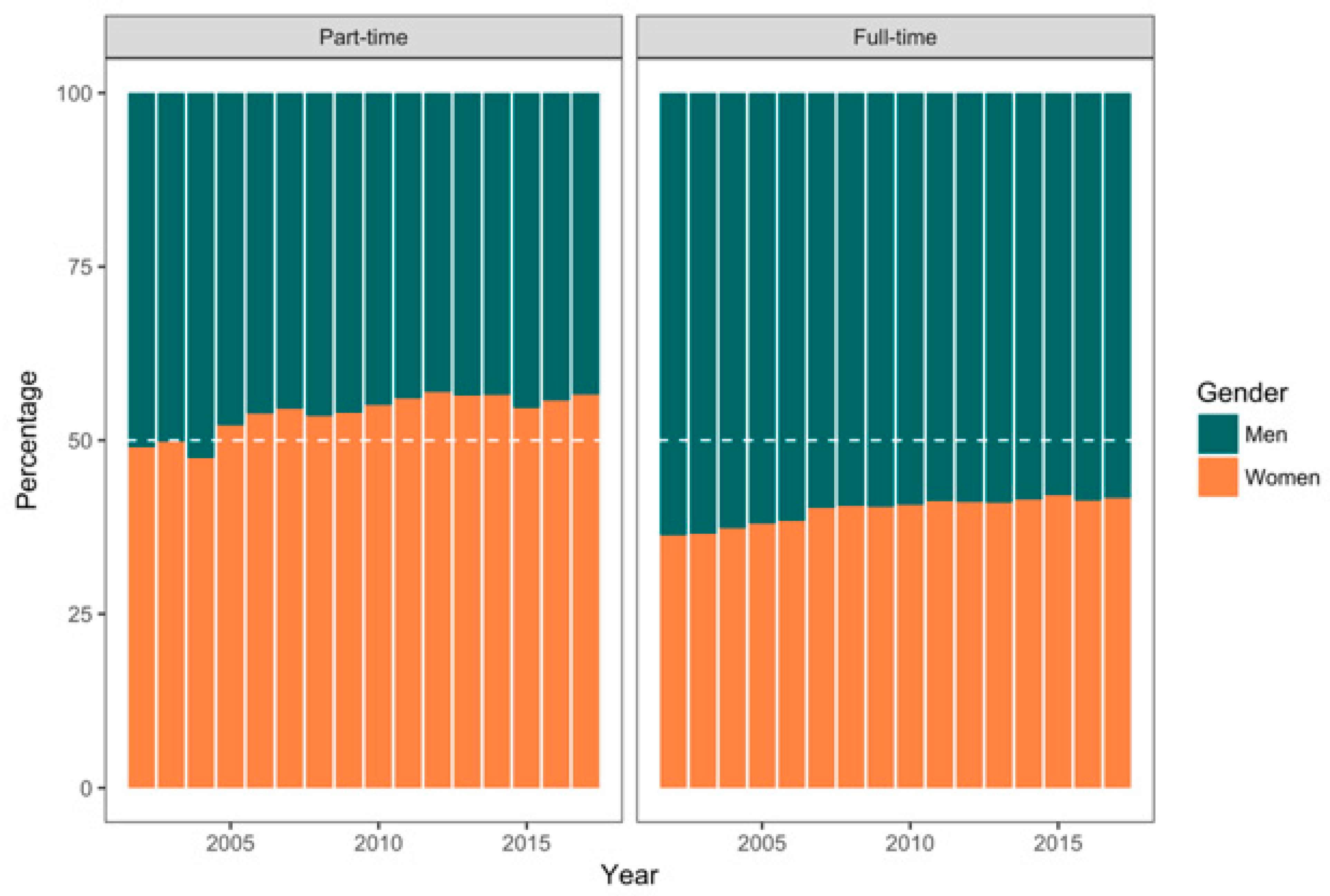
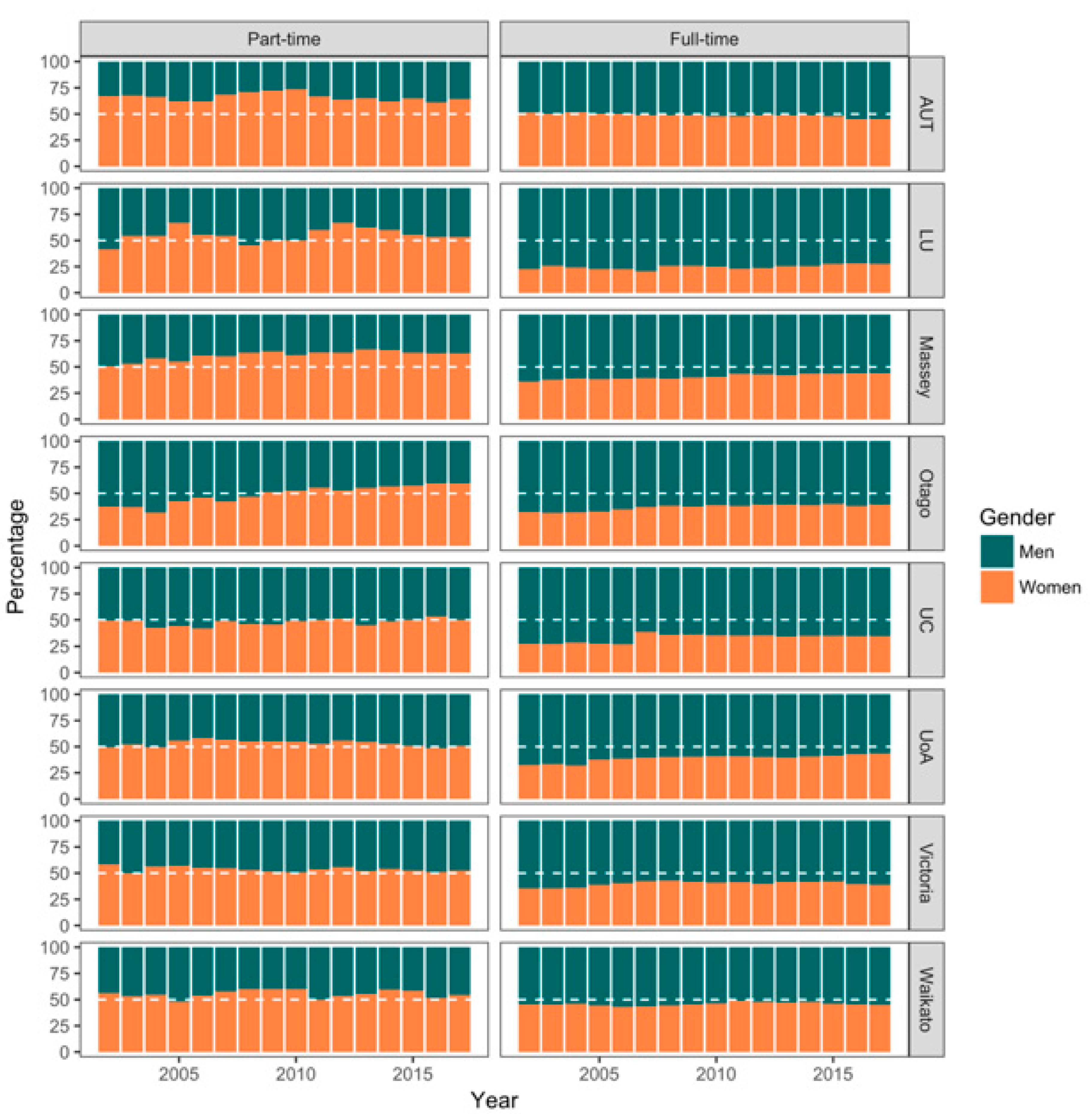
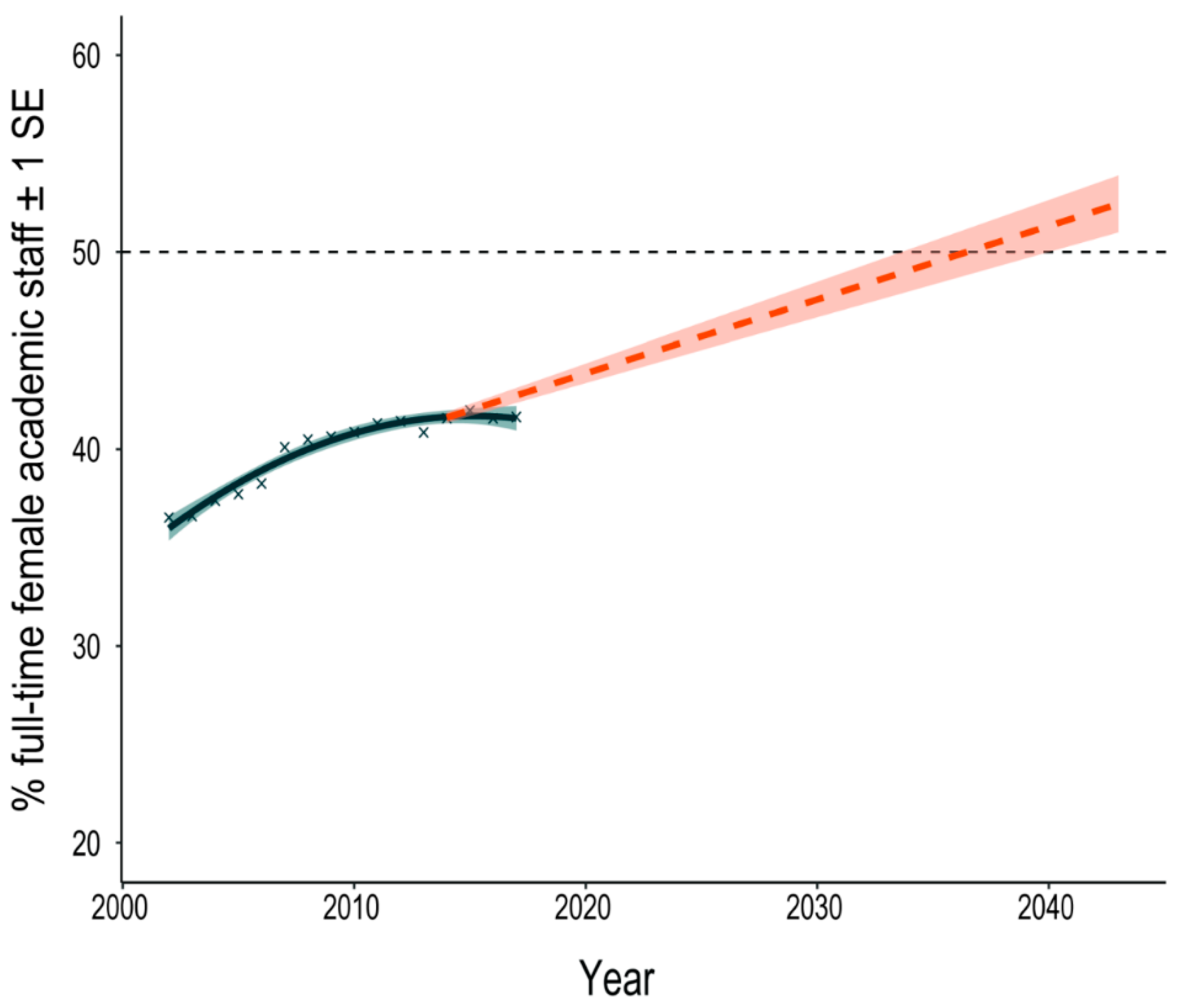
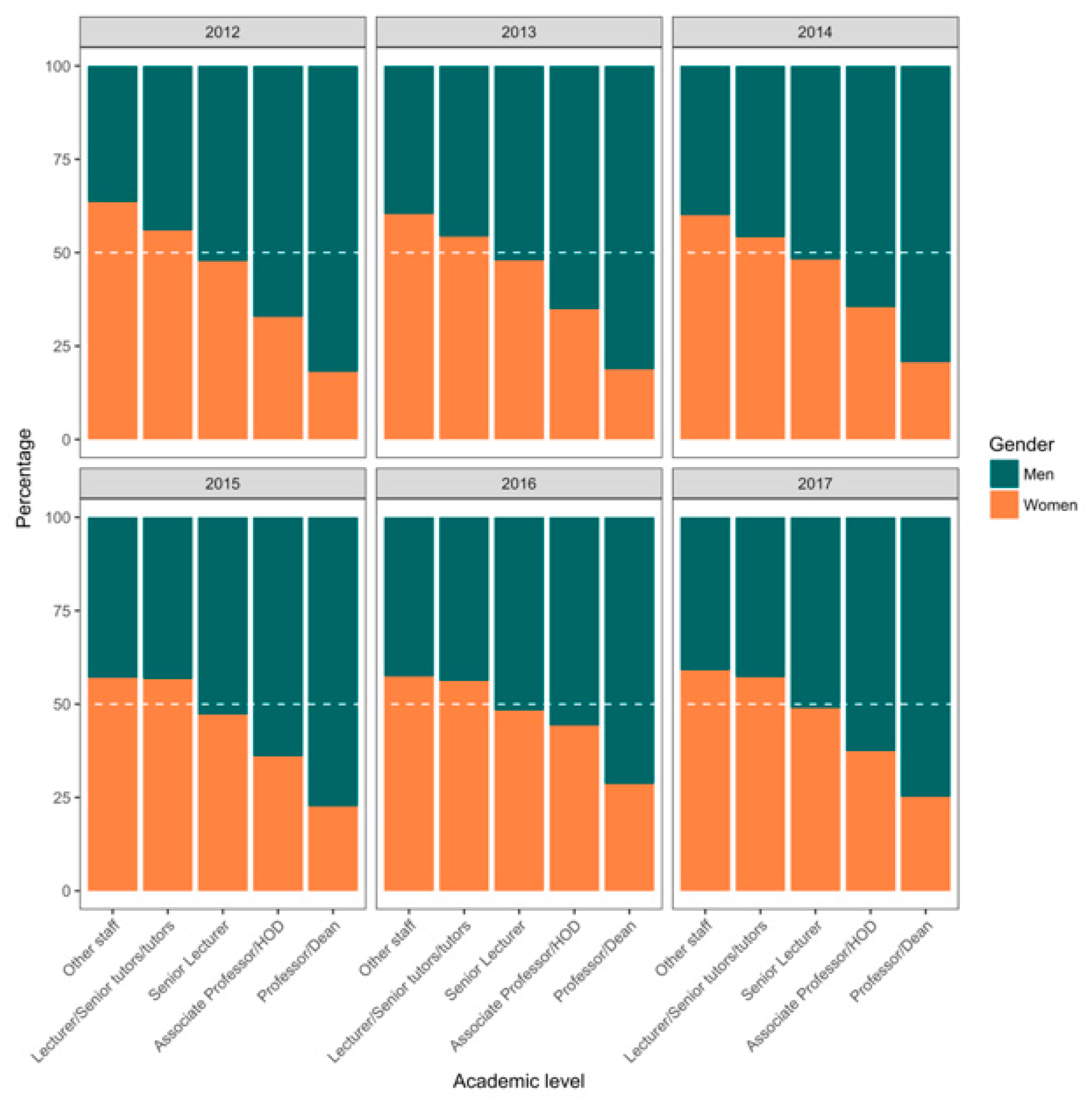
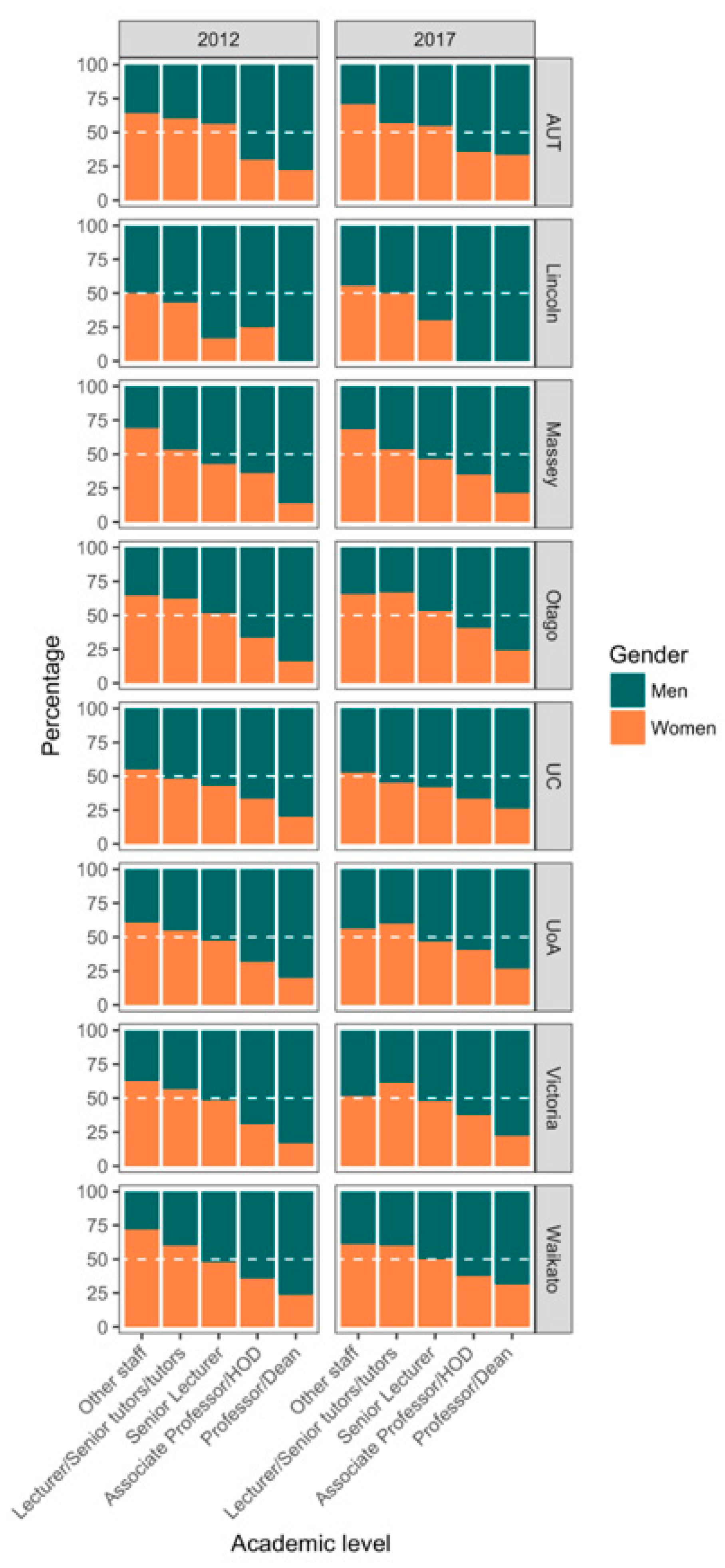

| Year | Name | Established | City | # Full-time Students | # Full-time Academic Staff |
|---|---|---|---|---|---|
| 2018 [48] | University of Auckland (UOA) | 1883 | Auckland | 21,108 | 1596 |
| 2018 [49] | Auckland University of Technology (AUT) | 2000 1 | Auckland | 20,013 | 1177 |
| 2017 [50] | University of Waikato (UW) | 1964 | Hamilton | 12,229 | 599 |
| 2017 [51] | Massey University (Massey) | 1927 | Palmerston North, Auckland, Wellington | 9892 | 1413 |
| 2018 [52] | Victoria University of Wellington (VUW) | 1897 | Wellington | 17,763 | 1090 |
| 2018 [53] | University of Canterbury (UC) | 1873 | Christchurch | 14,070 | 777 |
| 2017 [54] | Lincoln University (LU) | 1990 2 | Christchurch | 2695 | 294.1 |
| 2018 [55] | University of Otago (UO) | 1869 | Dunedin | 21,108 | 1596 |
| Part-time | Full-time | |||
|---|---|---|---|---|
| University | Women | Men | Women | Men |
| Auckland University of Technology | 64.4% | 35.6% | 45.4% | 54.6% |
| Lincoln University | 53.3% | 46.7% | 28.6% | 75.0% |
| Massey University | 63.1% | 36.9% | 44.0% | 56.0% |
| University of Auckland | 50.8% | 49.2% | 43.4% | 56.2% |
| University of Canterbury | 50.0% | 50.0% | 34.8% | 65.2% |
| University of Otago | 59.7% | 40.3% | 45.4% | 54.6% |
| University of Waikato | 54.3% | 45.7% | 28.6% | 75.0% |
| Victoria University of Wellington | 52.9% | 47.7% | 44.0% | 56.0% |
© 2020 by the authors. Licensee MDPI, Basel, Switzerland. This article is an open access article distributed under the terms and conditions of the Creative Commons Attribution (CC BY) license (http://creativecommons.org/licenses/by/4.0/).
Share and Cite
Walker, L.; Sin, I.; Macinnis-Ng, C.; Hannah, K.; McAllister, T. Where to from Here? Women Remain Absent from Senior Academic Positions at Aotearoa New Zealand’s Universities. Educ. Sci. 2020, 10, 152. https://doi.org/10.3390/educsci10060152
Walker L, Sin I, Macinnis-Ng C, Hannah K, McAllister T. Where to from Here? Women Remain Absent from Senior Academic Positions at Aotearoa New Zealand’s Universities. Education Sciences. 2020; 10(6):152. https://doi.org/10.3390/educsci10060152
Chicago/Turabian StyleWalker, Leilani, Isabelle Sin, Cate Macinnis-Ng, Kate Hannah, and Tara McAllister. 2020. "Where to from Here? Women Remain Absent from Senior Academic Positions at Aotearoa New Zealand’s Universities" Education Sciences 10, no. 6: 152. https://doi.org/10.3390/educsci10060152
APA StyleWalker, L., Sin, I., Macinnis-Ng, C., Hannah, K., & McAllister, T. (2020). Where to from Here? Women Remain Absent from Senior Academic Positions at Aotearoa New Zealand’s Universities. Education Sciences, 10(6), 152. https://doi.org/10.3390/educsci10060152






